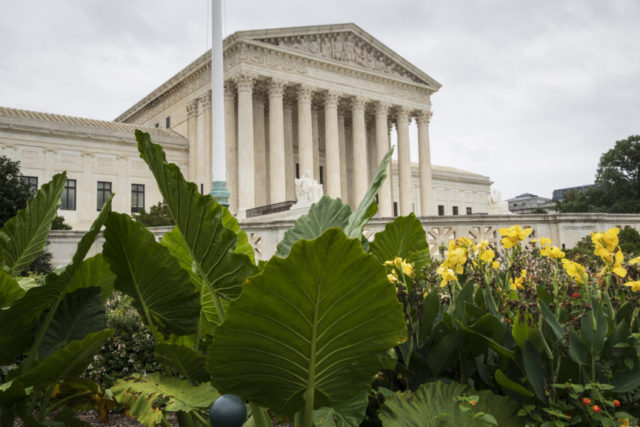WASHINGTON (AP) — It’s the storm before the calm at the Supreme Court.
Americans watched Thursday’s high court nomination hearing of Judge Brett Kavanaugh with rapt attention. The televised spectacle was filled with disturbing allegations of sexual assault and Kavanaugh’s angry, emotional denial.
On Monday, the court will begin its new term with the crack of the marshal’s gavel and not a camera in sight.
The term’s start has been completely overshadowed by the tumult over Kavanaugh’s nomination.
Republicans had hoped to have Kavanaugh confirmed in time for the court’s first public meeting since late June, an addition that would cement conservative control of the court.
Instead, there are only eight justices on the bench for the second time in three terms, with a breakdown of four conservatives and four liberals. The court was down a member in October 2016, too, following the death of Justice Antonin Scalia. Justice Neil Gorsuch joined the court in April 2017, after all but about a dozen cases had been argued
It’s unclear how long the vacancy created by Justice Anthony Kennedy’s retirement in July will last. Consideration of Kavanaugh’s nomination by the Senate has been delayed while the FBI undertakes an investigation of Christine Blasey Ford’s allegation that Kavanaugh sexually assaulted her in 1982.
An empty seat on the bench often forces a push for compromise and leads to a less exciting caseload, mainly to avoid 4-4 splits between conservatives and liberals.
The cases the court has agreed to hear so far this term look nothing like the stream of high-profile disputes over President Donald Trump’s travel ban, partisan redistricting, union fees and a clash over religious objections to same-sex marriage that the court heard last term.
“It’s a time of transition for the Supreme Court,” Solicitor General Noel Francisco, the Trump administration’s top Supreme Court lawyer, told a Federalist Society meeting in Washington recently.
Kennedy won’t be on the bench for the first time in more than 30 years, meaning lawyers will not have to aim their arguments at attracting his swing vote. Now, Chief Justice John Roberts probably will be the justice closest to the center of the court, although he is far more conservative than Kennedy on most issues.
“All eyes ought to be on the chief justice,” said Greg Garre, a solicitor general during George W. Bush’s presidency. Roberts’ votes in favor of President Barack Obama’s signature domestic legislation, the Affordable Care Act, show “he’s willing to buck other conservatives on hot-button, high-profile issues,” Garre said.
In addition, even if Kavanaugh or another Trump nominee eventually joins the court, Roberts’ concern about the public’s perception of the court might make him unwilling to move the court too far, too fast in any direction, Garre said.
So far, the court has agreed to hear about 40 cases, and could add a few dozen more to decide by the end of the term in June.
The very first case involves the federal government’s designation of Louisiana timberland as critical habitat for the endangered dusky gopher frog, though the frog is found only in Mississippi.
Two cases involving the death penalty will be argued in the first two months, including one on Tuesday in which lawyers for Alabama death row inmate Vernon Madison argue he shouldn’t be executed because strokes and dementia have left him unable to remember the details of the killing of a police officer in 1985. In November, Missouri inmate Russell Bucklew says he shouldn’t be subjected to execution by lethal injection because he has a rare medical condition that could cause him to choke on his own blood during an execution.
The court stopped both executions on the days they were supposed to take place, which often suggests the inmate will prevail in the end. But Kennedy was a vote for the inmates in both cases, and it’s not clear there is a majority of five justices for either Madison or Bucklew.
The court will also take on issues including the detention of immigrants, uranium mining in Virginia and the settlement of a class action lawsuit involving Google where the settlement largely directed money to organizations rather than search engine users.
Supreme Court terms often get off to a slow start, then roar to their finish.
Francisco, in his Federalist Society talk, suggested that could be the case over the next few months.
“The real key to the coming term is what’s in the pipeline,” he said.
Lawsuits over the Obama-era program that shields young immigrants from deportation, a new challenge to the health care law, anti-discrimination protections for LGBT people, the Trump policy on transgender service members and a new fight over partisan gerrymandering all are percolating in federal courts and could reach the justices this term.
Another wild card is special counsel Robert Mueller’s Russia investigation and the possibility that he could try to force Trump to testify to a grand jury or, perhaps less likely, indict him. The court has never directly addressed either issue regarding a president.
___
For more coverage of Brett Kavanaugh’s Supreme Court nomination, visit https://apnews.com/tag/Kavanaughnomination

COMMENTS
Please let us know if you're having issues with commenting.